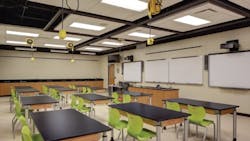In April 2013, a new set of voluntary, rigorous and internationally benchmarked standards for K-12 science education was released. The standards, known formally as the Next Generation Science Standards (NGSS), were developed, written and revised by a team of 41 teachers and education leaders from 26 states.
Identifying the Need
Prior to the 2013 release of the NGSS, nearly 15 years had passed since the National Research Council (NRC) and the American Association for Advancement in Science (AAAS) had updated their K-12 science education standards, which many districts presently use as a guiding framework for developing their science curricula. But as science is an ever changing and advancing field, there was a clear need for an updated set of standards.
Furthermore, research indicates that U.S. students lag behind their international counterparts. The 2012 Program for International Student Assessment (PISA) ranked the U.S. education system 23rd in science literacy and 30th in math literacy out of the 65 total OECD (Organization for Economic Co-operation and Development) education systems. For PISA, the OECD surveys 15-year-old students worldwide every three years.
Improving U.S. student achievement and preparing students for success in the global economy involves transforming the ways in which students learn. A traditional lecture-style classroom, with rows of desks facing a blackboard, is no longer effective as a classroom that promotes collaborative learning and student engagement. Educational facilities must better accommodate the needs of students and nontraditional forms of learning. NGSS aims to pull together inquiry and practice and properly recognize the roles of science and engineering.
According to the NGSS website, the standards were developed using three guiding dimensions: practices, crosscutting concepts and disciplinary core ideas. Practices describe behaviors involving scientific investigation and the knowledge specific to each investigation. Crosscutting concepts link different fields of science. Disciplinary core ideas focus on K-12 science curriculum, instruction and assessment related to science’s most imperative aspects, including problem solving, connectedness to societal and individual concerns, and depth of sophistication. This interdisciplinary approach requires science rooms to conform to a variety of different functions, allowing students to plan, investigate, analyze and construct explanations and solutions.
Shaping Facilities around NGSS
This set of science standards works best only when facilities support this interdisciplinary approach to learning. We often refer to this approach as “student-centered learning.” Students choose how they learn, where they learn and with whom they learn. Collaborative learning and flexible spaces are plentiful, and science labs promote student interaction and investigation. The traditional lecture and memorization approach is replaced with inquiry, investigation and problem solving. Students develop a deeper understanding and learn to be better decision makers, preparing them for success in the “real” world.
This approach requires a space that allows students to work together to explore scientific principles: large, open surfaces, unencumbered with fixtures or equipment; a technology-rich environment to assist in their exploration of forces and interaction. The student-centered science room accommodates these requirements without adding excess space. Students need to present, demonstrate, engage, evaluate and communicate information within a single location.
As of March 2014, only 11 states had officially adopted NGSS, but many other states have shown interest. PRA recently worked with the administration and teaching staffs at the Waterloo and Beaver Dam Unified School Districts in Wisconsin to renovate their high school science departments to better accommodate student needs (see related article).
A Multipurpose Space
Analytical and strategic thinking often encompasses three stages: defining the problem, developing the solution(s) and improving the design. The student-centered design of tomorrow’s science rooms fosters progress through all stages in one location. Workstations function as places where hands-on project experiments, computational analysis and presentation formation can occur simultaneously. Separate areas for these activities no longer represent effective use of space.
By providing one presentation/evaluation space in each science room, the total square footage is minimized and functions are consolidated to provide efficiency and safety within the learning environment. This design allows flexibility within the classroom; the designated presentation/evaluation space provides teachers with an opportunity to present information in a more traditional format and allows students to collaborate within a less structured environment.
Revising and restructuring an entire district’s science curriculum is not a simple task. It requires significant staff, administration and community collaboration and support, and a significant time commitment. However, if we are to best serve students, it is our goal as architects and designers to provide spaces that foster collaboration and encourage problem solving, critical thinking and decision making, preparing them for success in the “real” world.
